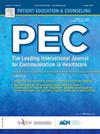Finding the right words: A skills-based curriculum using verbal procedures to address implicit bias in clinical encounters
IF 3.1
2区 医学
Q2 PUBLIC, ENVIRONMENTAL & OCCUPATIONAL HEALTH
引用次数: 0
Abstract
Introduction
Implicit bias can influence patient-clinician communication through clinician implicit bias (actual) or patients’ perception of bias (perceived). Few curricula focus on skills to address implicit bias. We developed and evaluated a skills-based curriculum addressing implicit bias in clinical encounters.
Materials & Methods
A 60-minute session was delivered to 4 cohorts of learners (N = 458, ranging from first-year medical students to attendings) in academic medical settings. All had prior exposure to the topic of implicit bias. Instruction grounded in the Implicit Bias Recognition and Management framework described the impact of actual and perceived bias and patients’ recommendations for restoring rapport once bias had impacted an encounter. Through audience response systems or role-plays with feedback, participants developed verbal procedures—personalized, verbatim statements to restore patient rapport when implicit bias has impacted an encounter. Learners submitted their verbal procedures online, which were then coded to identify helpful and unhelpful elements. Investigators coded verbal procedures and assigned point values for “helpful” and “unhelpful” elements resulting in scores from −1–6.
Results
Each approach yielded helpful elements. Overall, of submitted verbal procedures, 91.3 % were “helpful” and 8.6 % “unhelpful.” Compared to audience response systems, verbal procedures developed through role-plays included significantly more “helpful” elements (2.21/1.29, p = 0.003 and 2.46/1.87 p = 0.009).
Conclusions
Findings suggest learners can develop verbatim statements to restore rapport with patients in a single session if those learners have prior foundational knowledge about implicit bias and its relevance to healthcare disparities.
Practice Implications
Teaching verbal procedures could expand skill-building opportunities within implicit bias curricula.
寻找合适的词语:一个以技能为基础的课程,使用口头程序来解决临床遭遇中的隐性偏见
内隐偏见可以通过临床医生内隐偏见(实际)或患者对偏见的感知(感知)影响医患沟通。很少有课程注重解决隐性偏见的技能。我们开发并评估了一个以技能为基础的课程,以解决临床接触中的隐性偏见。材料&方法在学术医疗环境中对4组学习者(N = 458,从一年级医学生到主治医师)进行60分钟的课程。所有人之前都接触过内隐偏见的话题。基于内隐偏见识别和管理框架的指导描述了实际和感知偏见的影响,以及一旦偏见影响了相遇,患者对恢复融洽关系的建议。通过观众反应系统或有反馈的角色扮演,参与者制定了口头程序——个性化的逐字陈述,以在隐性偏见影响会面时恢复患者的融洽关系。学习者在网上提交他们的口头程序,然后将其编码以识别有用和无用的元素。研究人员对口头程序进行编码,并为“有益”和“无益”因素分配分值,得分从−1-6。结果每一种方法都产生了有益的因素。总的来说,在提交的口头程序中,91.3% %“有帮助”,8.6% %“没有帮助”。与观众反应系统相比,通过角色扮演开发的口头程序包含了更多的“有用”元素(2.21/1.29,p = 0.003和2.46/1.87 p = 0.009)。结论研究结果表明,如果学习者事先对内隐偏见及其与医疗保健差异的相关性有基本的了解,学习者可以在一次会话中逐字逐句地复述以恢复与患者的融洽关系。实践启示:在隐性偏见课程中,教授语言程序可以扩大技能培养的机会。
本文章由计算机程序翻译,如有差异,请以英文原文为准。
求助全文
约1分钟内获得全文
求助全文
来源期刊

Patient Education and Counseling
医学-公共卫生、环境卫生与职业卫生
CiteScore
5.60
自引率
11.40%
发文量
384
审稿时长
46 days
期刊介绍:
Patient Education and Counseling is an interdisciplinary, international journal for patient education and health promotion researchers, managers and clinicians. The journal seeks to explore and elucidate the educational, counseling and communication models in health care. Its aim is to provide a forum for fundamental as well as applied research, and to promote the study of organizational issues involved with the delivery of patient education, counseling, health promotion services and training models in improving communication between providers and patients.
 求助内容:
求助内容: 应助结果提醒方式:
应助结果提醒方式:


